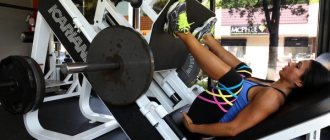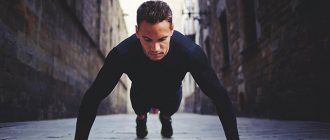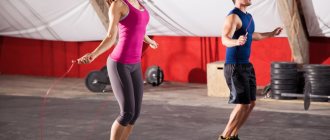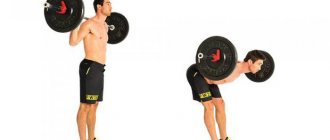These simple exercises can be done every day instead of warming up. Your body will be flexible, resilient, your muscles will always be in good shape.
Jumping Jacks involve jumping with your feet wide apart and your arms touching your head and extending high above your head and bringing your palms together to form an X as you swing your arms and legs, then returning to the starting position with your legs together and your arms together. on the sides of the body. This exercise is also a general warm-up before starting sports. So, what are the benefits of jack jumping exercises?
Pros of exercise
- Exercise promotes weight loss due to its high energy consumption when performed correctly.
- Improves blood circulation, increases the overall endurance of the body.
- Strengthens the cardiovascular system.
- It is performed without additional equipment; in order to change the load, the pace or complexity of the technique can be increased.
- The exercise can also be simplified by performing a less impact version without jumping.
- Suitable for most athletes, regardless of training level.
Semicircular kick (roundhouse kick)
When delivering this blow, the leg makes a movement similar in trajectory to a side blow with the hand. The leg bent at the knee is brought forward and upward. This is followed by a turn of the foot of the supporting leg (the heel is more or less directed towards the opponent); the shin and foot of the striking leg, as well as its thigh, are brought into a position where they all lie in the same horizontal plane, and from here a semicircular blow is delivered. The blow can be delivered to the head, torso, or thigh. In the latter case, it is classified as a kick to the lower level of legal targets (low kick).
The semicircle kick is used more often than other kicks in combat. It is applied primarily with the instep of the foot, although it can also be applied with the part of the foot that is used for the front kick.
Jumping jack technique
- Stand straight with your feet together (if stability is not enough, you can place your feet hip-width apart). Lower your arms freely along your body.
- Exhale and jump with your feet wider than shoulder-width apart while raising your arms above your head. When lifting, your arms should be bent at the elbow joints. Jumps are performed gently on slightly bent knees, landing on your toes.
- As you inhale, jump back to the starting position - lower your arms along your body and bring your feet together.
- The abdominal muscles should be tense.
- Repeat the movements as many times as necessary.
LiveInternetLiveInternet
A beautiful figure requires a lot of time, effort and financial investment. This is the stereotype that has developed in modern society. However, experts believe that the inability to follow it for any reason can be completely compensated for by a few physical exercises a day and proper nutrition. We'll talk about the first point. More precisely, about the healing effect that the “Jumping Jack” (or “Jumping Jack”) exercise gives. How to perform it correctly and what do reviews from experienced athletes say?
Target muscles
It is known for sure that “Jumping Jack” is an exercise that is used to train soldiers’ endurance. The main load when performing it falls on the hips. The abdominal and calf muscles take a secondary role. It is noteworthy that it does not require extensive space for training and additional equipment in the form of dumbbells or a jump rope. It is enough to use your own body weight.
Effect
It is difficult to fully assess the effect that Jumping Jack (exercise) has. Photos and videos of its implementation demonstrate its simplicity, but almost all muscle groups are involved. During regular training, flexibility develops and coordination of movements improves. The exercise carries a certain aerobic load. The rapid formation of a toned figure is also noted: for example, the sides, which fitness trainers usually call “ears,” disappear. When done correctly, the buttocks become firmer and the saggy belly disappears. The anti-cellulite effect and beneficial effects on the respiratory system should not be excluded. To quickly experience all this for yourself, you need to train regularly, following a regimen and increasing the time and number of approaches.
Minuses
The Jumping Jack exercise is sometimes called a running alternative for lazy people. After all, despite the dynamics, it excludes forward movement and resistance to air flow. Of course, it can and is even recommended to be done in the fresh air. However, it will never replace a healthy morning jog or walk. And to achieve the desired effect, “Jumping Jack” is best performed in conjunction with other active activities. This is perhaps the only disadvantage of this exercise. Professional athletes, by the way, use it to warm up their body muscles.
Contraindications
Contraindications in this case do not differ from standard recommendations for exercises labeled “cardio”. The Jumping Jack exercise should not be practiced by people with injuries to the spine, knee joints, or serious diseases of the cardiovascular system. The postoperative period is also a contraindication. Before training, it is best to consult a doctor or fitness instructor.
Execution technique
After this description, people without any limitations will naturally want to try the Jumping Jack exercise. The technique for doing it is quite simple. Starting position: stand straight, place your feet shoulder-width apart, and keep your arms straight and at your sides. Inhale and as you exhale, jump. At the same time, spread your legs wider to the sides, and sharply raise your arms above your head and clap your palms. After this, you can return to the starting position by inhaling. And again, as you exhale, repeat the jump. Watch your breathing and pace.
Option 2. Clapping overhead is performed to control breathing and the rhythm of the exercise. However, it is not necessary to do this. Alternatively, you can raise your arms up with open palms facing forward. If additional load on the arm muscles is required, you can take light hand dumbbells or fix special weight bags. However, in this case, the intensity, duration and quality of the workout may be reduced. It is better to move to this level after significant physical training.
Adviсe
How to do the Jumping Jack exercise is already clear. General techniques are usually learned quickly. However, despite the apparent ease, there are many nuances here.
- It is necessary to follow them to obtain the correct physical result. Maintain the pace of the exercise. It must be fast and constant. If there is a hitch or failure, then it is better to stop and start over. Music or counting can be used to help control breathing and rhythm.
- When jumping, do not arch your back or slouch. The back should be straight. Stretch your arms up. To maintain balance, your gaze should be directed forward. For stability, your feet can be slightly spread to the sides.
- If the exercise is performed in several approaches, then the rest interval should not exceed a minute. If it takes longer, it may negatively affect your heart rate.
- Also, before practicing the Jumping Jack exercise, you need to stretch your body a little, in particular your ankle, knee and shoulder joints.
- This exercise should be performed in comfortable clothes without jewelry or jewelry. It is important to maintain maximum comfort and freedom so that nothing disturbs the rhythm.
- The Jumping Jack exercise is recommended to be performed half an hour or an hour before meals. After practicing it, you need to walk a little so that your heart rate returns to normal. You are allowed to drink some water.
- Never sit or lie down after training. This recommendation applies to all types of active exercise.
- “Jumping Jack” energizes the body and allows you to maintain your tone until the evening. Therefore, the ideal time to practice it is in the morning. Moderate physical activity before bed can cause insomnia.
- And, of course, a positive attitude during training is very important. It gives lightness to the body and confidence in one's abilities. Loads should be reasonable, in accordance with the state of health and characteristics of the body.
Reviews
Many professional athletes and adherents of a healthy lifestyle confirm the positive effect that the Jumping Jack exercise gives. How to do it correctly? This question is not difficult. The result is much more significant. To quickly achieve it, instructors recommend practicing the exercise for at least 15 minutes a day.
A fast pace promotes good blood circulation in the body, saturating it with oxygen and, as a result, increasing metabolism. That is why many women and men use this exercise to quickly and effectively lose weight and shape their figure. Of course, it is better to use it in combination with other physical activities. According to the unanimous opinion of experts, the Jumping Jack exercise is a bold leap into a healthy future. If you do it correctly and regularly, and all this is supported by proper nutrition, then you can soon find an attractive figure and a healthy shape.
Complication Variations
Half squat jumps
When the muscles adapt to the load, you can complicate the option by performing half-squat jumps.
The exercise is performed like this:
- Place your feet together, squat slightly with your knees bent, and bring your forearms together with your elbows bent in front of you.
- Exhale, push off with your feet and jump, spreading your feet wider than your shoulders, while simultaneously raising your arms to the sides above your shoulders.
- As you inhale, simultaneously jump back into a half-squat and bring your forearms together in front of you.
Jumping with a dumbbell
For more advanced athletes who want to increase the load on the shoulder girdle, you can add jumps while lifting the dumbbell upward.
This is done as follows:
- Place your feet together and firmly hold a dumbbell of a suitable weight in your hands by the weighting discs on your sides at the level of your collarbones. The elbows are directed downwards.
- With an exhalation, perform a simultaneous jump and lift your arms with weights upward, straightening your elbow joints.
- As you inhale, jump your feet together and lower the dumbbell to the starting position, bending your elbows.
Jumping with a fitness band
To add additional weight and increase the load on the leg muscles, you can use a fitness elastic band or mini-band.
Technique:
- Place the band on your shins, placing your feet close to each other, but so that the band does not fly off. Place your arms freely along your body.
- As you exhale, jump with your feet apart, stretching the band and feeling resistance while raising your arms above your head. You can do a clap at the top.
- As you inhale, return to the starting position.
Health Benefits of Performing Jack Jumps
Jumping Jacks - Exercises to Maintain Heart Health
Jumping Jacks are exercises that use oxygen to stimulate energy needs and strengthen the heart muscles. This causes the heart to stay healthy and active, pumping more blood and releasing more oxygen.
Burn calories and maintain stable weight
Cardio exercise is known to burn calories and therefore promote weight loss . A person who weighs about 68 kilograms can burn about 19 calories by performing a 2-minute session of jumping jacks that consists of approximately 100 spins. When the same person performs jumping jacks for a total of 10 minutes, with intervals between sets, the figure of 94 calories can be achieved.
Improve coordination of movements
Jumping Jack - help develop coordination of movement of the limbs of the body. This, in turn, will improve coordination between brain signals and limbs, which is good for motor development .
Jumping Jacks can be used for recreation
Because this is a form of stress relief , since when doing physical exercise, happiness hormones are produced (for example, serotonin - the hormone of good health). Additionally, the adrenaline rush also creates excitement along with an increase in energy. These hormones, when combined, reduce stress levels and increase feelings of happiness.
Jumping Jack is a good workout
One important thing to always do before working out, as well as in your daily life in general, is to warm up to prevent pain, cramping or similar discomfort. Perform Jumping Jack 8-20 times as your daily warm-up routine.
Jumping Jacks work the whole body
The Jumping Jack uses the entire body because self-rotation forces the entire body to move. Namely: biceps, triceps, glutes, core, pectoral muscles, hamstrings, as well as all the major muscles of the body!
Jumping Jacks improve flexibility
Yes, indeed, Jumping Jack improves flexibility! As we know, children love to jump, which makes them both active and flexible. Additionally, if we do not maintain our flexibility, such as by sitting for long periods of time during the day, our body will have difficulty performing even the simplest stretch. That's why warm up every now and then to maintain flexibility even at low intensity.
Subscribe to our VIBER channel!
When muscles don't work, our body becomes weak and becomes covered in fat deposits. Jumping Jack helps us to lose fat and calories that we have collected throughout the day. They train the muscles of the arms, legs, thighs, and buttocks. It is worth performing jumps every day, about 100-200 times, but no more than an hour and a half.
Jumping Jack as a way to improve stability and endurance
Jumping up and down from one position to another will improve our stability. As for endurance, it increases because, as stated above, jumping tones the muscles. The more sets and reps you do, the better your endurance becomes. Box jumps are also used to develop endurance.
Benefits of jumping jack for weight loss
Since the exercise is aerobic and can be performed for a long time, with a sufficient heart rate, energy will be consumed from fat reserves, but provided that the workout lasts at least 30-40 minutes.
Despite the fact that the exercise is fat-burning, it is not enough to perform one approach for the entire workout. For the effect to be visible, it is necessary to combine jumping with other exercises (possibly with strength ones), alternating the load. The main condition is a sufficient duration of training, only then will the exercises contribute to weight loss.
More about workouts for weight loss → More about workouts for weight loss for men →
Jumping kicks
Almost all strikes (including punches) can be delivered while jumping. This gives them a certain uniqueness. However, such attacks are used infrequently. They are spectacular, but ineffective. The only exception is, perhaps, a backward kick. In addition, jumping strikes disrupt the rhythm of the fight and take a lot of energy.
Speaking about kicks, it should be noted that they are used extremely unevenly. The most commonly used are semicircular and reverse circular strikes with a turn; chopping strikes are used very rarely, and in many fights athletes do without them.
Reflexology
There are many active points on our hands and feet, stimulating which we can activate blocked internal energy. Each area of the foot and palm is responsible for a specific system, group of organs or part of the body. There are different techniques and methods of working out, reflexology is a whole science, people have been learning this for years. However, you don’t need to be a great specialist to give yourself the simplest self-massage. If possible, warm your hands in hot water. Then use the pad of your thumb to gently knead the palm of your other hand in a circular motion, applying gentle pressure. Start from the center of the palm, then move in a clockwise spiral. After this, move to the back of your hand, massage along the metacarpal bones from the wrist to the base of the fingers, then each finger from the base to the tip - and so on both hands.
Jump territory
Any object is first “jumped” by team members, that is, professionals. Having established the base, they jump in every possible way - bag, with flips, with deliberate mistakes, to make sure that under no circumstances can the amateur injure himself. Only then the object is “opened” for amateur rope jumping under the control of the team. But even then, the first jump must be made by a professional - to make sure that the base is installed correctly. Laser rangefinders and experience are used to calculate installation distances.
To prevent the carabiners from “spinning” in the knots of the rope, they are additionally wrapped with tape. “Scotch is our everything! - Viktor Usakov, a technician from the Project F/X team, laughs. “If you forgot the tape, it means that the site visit did not take place.” Basic ropes are usually tied with two (or more) arbor knots.
People who come to jump are divided into three categories. The first are those who jump just once, in order to check the box. The second is those who like it. They are interested in jumping from a new object every time, from a new height. They jump with different teams (after all, different teams have different objects), gradually “covering” the Moscow region, and sometimes they go on long jumping expeditions. The third category, as Jacques says, is “the slightly touched, like ourselves.” That is, people who jump always, everywhere, at every exit, without missing a beat, and depend on jumping like drug addicts. Adrenaline junkies.
Usually three team members send the jumper flying. Two people attach the belay and ropes to him, with one controlling the other. Such self-control is mandatory: any inattention can lead to serious injury. The third is located at the place where the base ropes are attached - it controls the jumper’s descent after the free fall phase is completed and he is hanging on the dynamics. Helmets are mandatory items. Of course, they won’t help if you fall to the ground, but they will save you from impact or friction with the rope (this happens regularly to beginners).
Rope jumpers are constantly in a state of search for new objects. For this purpose, expeditions are organized not only within a radius of hundreds of kilometers from the city where the team is based, but also much longer trips. “Project F/X” traveled to Abkhazia, Khakassia, and Crimea. There are much more objects in mountainous areas than in plains; The natural origin of these objects is especially attractive. In the Caucasus there are many jumping points with a height of 150-200 m (of which up to 90 m of free fall).
Illegal punches in Kickboxing
Illegal strikes in Kickboxing for Full Contact and Full Contact with Low Kick are:
- Attack the throat, kidneys, back, legs, joints, groin, back of the head and neck.
- Attack with knees, elbows, open hand, head, thumb, shoulders.
Also prohibited are blows to the leg joints, blows to the knee and under the knee, as well as a direct kick to the opponent’s leg.
Allowed strikes in Kickboxing for Full Contact and Full Contact with Low Kick are:
Jumping is an exercise from childhood
The jumping jack is an exercise that everyone knows, but not everyone does it. Perhaps the fact that children are already trying to get to know him in kindergarten means that we do not take these exercises seriously. Meanwhile, fast and technically correct jumps can cause shortness of breath; after all, jumping jacks are aerobic exercises that require a lot of energy. We must also remember that they not only often appear in the warm-up plan before classes in fitness clubs, but are also part of circuit training or in people who practice gymnastics. Moreover, bouncing vigorously while doing the exercise is a good way to burn a lot of calories.
This exercise works different muscle groups: the shoulder, gluteal and abductor muscles in the hip joint, arms, back and legs. This exercise speeds up your heart rate, which means it improves blood flow to your muscles, and as part of your warm-up, minimizes the risk of injury and soreness.
Advice for pregnant women
The American College of Obstetricians and Gynecologists (ACOG) recommends that pregnant women do 20 to 30 minutes of moderate physical activity per day during all trimesters of pregnancy. Exercise improves physical fitness, manages a healthy weight, and even prevents the risk of gestational diabetes.
At the same time, ACOG does not specifically indicate that pregnant women should avoid jumping, but instead use “low-impact aerobics” as an alternative. If in doubt, you should consult your gynecologist about what exercises can be done during the different trimesters of pregnancy, especially since pregnancy greatly affects joints, bone structure and stability. Published by econet.ru.
PS And remember, just by changing your consciousness, we are changing the world together! econet
Jumping jack technique
The word “jumping” already hints that we are talking about jumping. That’s right - we are talking about jumps, which are the basis of the exercise.
It is performed as follows:
- In the starting position, you need to stand up straight and place your feet shoulder-width apart and lower your arms.
- Inhale and as you exhale, jump.
- During the jump, the legs are spread even wider to the sides, and the arms are raised above the head until the palms clap.
- After this there is a return to the starting position.
- Then the exercise is repeated.
There is another option:
The clap is performed to make it easier to maintain the rhythm of the exercise and monitor breathing, but this is an optional element. Instead of clapping, you can raise your hands with your palms facing forward.
During the workout, you need to monitor your breathing and pace, and not lose the rhythm. In order for the exercise to give the desired effect, you need to perform it regularly and follow a training regimen . Gradually, the number of approaches and training time can be increased.
For additional exercise, you can pick up small dumbbells or wear weights. But you need to keep in mind that at first this may shorten the training time and reduce its intensity. Therefore, it is better to switch to jumping with weights after sufficiently long training.
Technique for performing basic kicks in point fighting (semi-contact)
Technique for performing basic kicks in point fighting (semi-contact)
Introduction.
Kicks are a very formidable weapon. The force of a kick is several times greater than the force of a hand. A correctly executed blow can cause much more damage to an opponent than the hand can do. Not only strength and speed depend on the correctness of the blow, but also protection from a possible counterattack by the opponent. In point fighting, the front leg works predominantly; the back leg works in rare cases and mainly in counterattacks. This is due to the fact that striking with the back leg will occur with a turn of the whole body in the direction of the blow. Experienced opponents will quickly react to this action and launch their own quick, anticipatory counterattack.
Due to their length and power, kicks are much more effective than punches. However, they are more complex in terms of technical execution. To better use your legs, you need to have good stretching, train and develop the muscles and give them elasticity through static exercises, working with rubber, on the paws and specialized equipment. Before considering the technical execution of kicks, you should pay attention to common errors and features.
Main part.
The main mistake in kicking is the understep. Step-up strikes are very common in ring disciplines. In point fighting, they need to be applied unnoticed, respectively, with a minimum number of actions. The understep is very noticeable to the opponent, and even if he does not get ahead of him with his attack, he certainly will not allow him to get to him. Another problem when throwing a kick is the loss of stability, as a result of which the blow becomes not so strong and vulnerable. The supporting leg should be slightly bent in order to absorb the blow and be able to push off to a long distance. The specifics of performing kicks in point fighting include the tilt of the body at the moment of the execution itself. Due to the deeper tilt and rotation of the hips, the range of the strike increases, which is a very important point for winning the fight.
One of the main elements of a kick is the extension of the knee and the placement of the feet. At the moment of raising the leg, the foot of the striking leg should be with the heel forward (towards the opponent). The striking leg first bends at the knee and rises as high as possible. The knee should be as bent as possible and close to the front shoulder. The foot of the striking leg is tense and ready to strike at any moment. The toe of the foot is raised up so that the opponent can see the entire sole from heel to toe. This position of the leg when striking will allow you to deliver a variety of kicks, and it will be difficult for your opponent to understand what kind of blow the opponent wants to deliver at the moment. The defense must also be placed correctly. The hands are in the same position as in a normal stance, and due to the high raised knee and the foot, which is in front of the face, the opponent will not be able to make a counterattack in the form of an overlay or put his leg on the opponent’s leg. Raising the knee to a high level is only possible with good stretching.
After the leg has made preparatory actions for the strike, it is time to extend the leg and deliver the strike itself.
In point fighting there are the following main kicks: front kick, roundhouse kick, side kick, ex kick, hook kick, jumping kick, foot kick.
Front kick (direct kick).
Rice. 1. Front kick
The front kick is not a common move in point fighting games, but when used at the right moment it can be very effective. The knee at the moment of straightening the leg looks up until the very last moment. By slightly turning the supporting leg, you can allow the pelvis to move into the striking leg, thereby lengthening the blow and giving it additional strength and power. The body leans back at the moment of impact, distancing itself from the opponent and imparting additional force to the blow due to the momentum. The foot of the supporting leg must stand firmly on the floor, since it is the only support, and besides, if the heel of the supporting leg is torn off the floor, the blow will not achieve the desired force (Fig. 1). Of course, there is a variant of performing this kick from the back foot, which can often be seen in ring disciplines. Here the front leg makes a slight turn, and then the back leg kicks in a straight line. Competitive experience has shown that executing a kick with the back leg can be effective when unexpectedly performed by the opponent, but when used infrequently.
Roundhouse kick (circular kick).
From the raised knee position, the front leg begins to straighten, and the knee itself turns to the inside, bringing the shin across the side in a circle. The foot of the striking leg is stretched with the toe forward. The blow is delivered with the top of the foot. As the leg straightens, the pelvis moves forward, giving the blow additional length and strength. The body may be slightly tilted to the side. The supporting leg is turned heel forward. This kick, just like the front kick, can be delivered from the back foot, but infrequently used (Fig. 2).
Rice. 2. Roundhouse kick
Side kick (side kick).
The front leg side kick is the most common strike in point fighting. Its frequent use directly depends on the stance and position of the legs. When impacting, the knee should be raised as much as possible, the foot of the supporting leg should be turned with the heel forward in the direction of the impact. At the moment of straightening the leg, the knee continues to remain the highest point. Only at the last moment, due to the rotation of the pelvis and the forward thrust of the thigh of the striking leg, the knee twists inwards, and the foot of the striking leg comes out to the top point and strikes. At the moment of the last stage of the impact, the body must remain straight and be completely turned sideways. The foot of the striking leg is in a rigid position, the blow is delivered with the full foot. The supporting leg should be slightly bent for better stability and a more effective push (Fig. 3). Correct execution of the “side kick” with the back foot is not effective in a combat situation, firstly, it is almost impossible to turn the front foot with the heel towards the opponent, and even if you leave the position of the front foot in a half-turned position, you need to almost completely turn around on the other side, and do this unnoticed by you can't learn from your opponent. It is very important to note that athletes often use the side kick in a counterattack, unlike other kicks. Here the technical execution of the blow changes slightly. The main thing is to move your whole body back as your first action, starting with your shoulders, which in addition to tilting also twist, showing your back to your opponent. When twisting with your back, you must look at the opponent from the beginning to the end of the blow, otherwise the judges may not count the point. The back leg should be turned with the heel towards the attacking opponent. The moment the whole body begins to move backward, the front leg rises into the kick. It is enough to raise the striking leg to the level of the opponent’s belt in order to hit the stomach, and sometimes even the head, since basically during his attack the opponent moves forward tilting his body very low. The striking leg may not be fully straightened, since the opponent moves forward in his attack and will bump into it himself, but you should hold the striking leg firmly and firmly. The main mistake in performing this counterattack occurs when the opponent leaves his body in place due to which he does not have time to raise the striking leg, missing the attack, or having managed to raise his leg, the collision occurs on both sides, and the judges often give a point to the attacking athlete for this action. It is imperative to move backwards away from your opponent. In this movement, you need to strongly bend your supporting leg, as if to move downwards from the opponent’s attack, so that his attack goes higher. This variation is the most common counterattack move in point fighting games.
Fig.3. Side kick
Ex kick (front leg kick).
This blow can be considered the most unexpected. From the position of the raised knee, the striking leg goes to the side and, making a semicircle, straightens up as much as possible. After the leg has reached its highest point, with a sharp, chopping movement it moves down, delivering a powerful blow. At the moment of impact, the pelvis is directed as far as possible towards the opponent, and the striking foot is stretched with the toe forward in order to further increase the length. This blow is delivered to the head and, in combination with other striking actions, is the most unexpected, since the striking leg bypasses the opponent’s defense (Fig. 4).
Fig.4. Ex-kick
Hook kick (roundhouse kick).
It is performed with a movement that has a trajectory opposite to the roundhouse kick. The blow is made by the back leg, which is carried forward - up - to the side and then the blow is struck backhand with the entire foot. In the ring sections of kickboxing, athletes try to deliver this kick with the heel so that the blow is much stronger, since there are no restrictions on rigidity. A roundhouse kick is delivered from the leg farthest from the opponent with a 180° turn, but at the moment the blow ends, the athlete can turn 360° or return back, depending on the combat situation. The body is turned through the back (having shown the back to the opponent, the striking leg begins its movement in a circle). From a bent position, the leg begins to straighten along its path, the phase of the maximum length of the leg should correspond to hitting the target. After delivering a blow, the leg continues to move along the given trajectory, completing a 360° turn, or if hit, it can return along the opposite trajectory. Subsequently, the athlete again takes the position in the usual combat stance. This blow should be well camouflaged, as it is vulnerable, but the most dangerous (Fig. 5).
Rice. 5. Hook kick
Jumping kick (jumping kick).
In point fighting games, jumping strikes are very diverse. They can be hit by simply jumping into the air, for example, by throwing a side kick or a roundhouse kick, or by throwing a jumping kick with a turn. The kick in a jump with a turn can also be varied, both 180° and 360°. At 180° it is possible to hit a “hook kick” (in a circle), usually to the head, and also, like a kick in taekwondo, “dwit-chagi” (a back kick with a heel turn in a straight path) is usually applied to the body, although there are also blows to head
The 360° jump kick, popularly called the “tornado”, is the most difficult kick (very often used in taekwondo). First, the athlete turns his body (over his back). During this turn, the legs are crossed. Next, the leg in front is the one with which the go-ahead will be made, while the leg behind strikes. To increase the impact, you need to twist the body (reverse).
Jump kicks, despite their complexity, are very effective. One such blow to the head can earn three points. They are also good to use in a counterattack with a retreat. Recently, you can increasingly see athletes trying to deliver such blows. For example, in the final of the 2010 European Championship in the weight category up to 69 kg. Richard Veres (Hungary) won the fight in the last seconds due to a jump kick, for which the judge gave him three points. In 2012, in the final of the European Championship in the category up to 57 kg. Davide Colla (Italy) in an equal match scored a three-point jump shot, and thereby broke his opponent, bringing the score to a clear advantage.
Foot kick (sweep).
The undercut is applied with the instep of the foot, its inner part and the heel. When cutting, it is very important not to make it too high, i.e. no higher than the opponent's foot level. The blow must be thrown exactly foot to foot, otherwise the referee may give a reprimand for an incorrect blow. The hook can be used both for a deceptive maneuver (feint) and to get a point. In the first variant, the athlete, distracting the opponent’s attention, makes a false movement in the form of a sweep, followed by an instant attack. Here the athlete does not set the goal of earning a point by cutting or unbalancing the opponent, the main task is to distract the opponent.
The sweep is carried out with a cutting movement of the leg and can be performed from the inside and outside; in addition, it can be performed with a movement similar to the “hook kick” strike, only at the opponent’s foot, most often this option is used under the supporting leg of the opponent’s fencing leg.
With the help of such strikes, a variety of combat tasks are solved: to solve the opponent’s balance, to reduce the tempo of the battle, etc. (Fig. 5).
Rice. 6. Foot kick
Conclusion.
Using pedagogical observation in a competitive environment, it is worth noting that there are very few athletes who use kicks as the basis of their fight, both at the Russian and international levels. And the effectiveness of such work is very high, as evidenced by the results of the World and European Championships. An athlete who has a high technique of footwork provides himself with a safe distance, control of the fight, and psychological pressure over the opponent, since the legs are a very powerful weapon in the fight.
Author: Honored Master of Sports of Russia, applicant for the 5th year of study at the Moscow State Academy of Physical Culture (Malakhovka), department: management, economics and history of physical education and sports - Mikhail Gerasimov.











